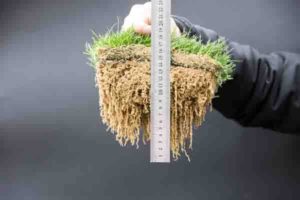Как сохранить гибридные поля травы?
В областях с гибридной травой, в местах, где гибридизационная машина не может войти или деформироваться, выполняется ручная гибридизация для быстрого восстановления изношенных участков. В естественных травяных полях это приложение применяется как процесс распространения семян. Корневая ориентация и время роста увеличиваются по таким причинам, как семена, летящие от ветра к месту, поедаемые птицами в качестве корма или не получающие необходимую воду, свет и температуру в зависимости от погодных условий. Кроме того, рулонная трава также применяется на естественных полях, чтобы реализовать процесс обновления в более короткие сроки. Однако это приложение является более экономичным, чем процесс распределения, который требует больших затрат.
Когда гибридные и естественные травы в областях исследования были изучены, было видно, что деформированные участки в гибридных областях обновлялись быстрее и в более короткие сроки в течение месячных периодов технического обслуживания. Как Hatko Sport, мы производим гибридные травяные поля высочайшего качества.
После гибридизации гибридные травяные поля попадают в солярий (искусственный дневной свет) и быстрее созревают. Таким образом, корни травы, которые обычно развиваются между 8-12 см, скручиваются в волокна глубиной 20 см, и поле готово быстрее.
На матчевых и тренировочных полях, подготовленных к чемпионату мира по регби 2015 года в Англии и Уэльсе, для анализа были отобраны 53 поля с натуральным и гибридным газоном, и были проведены некоторые механические испытания для измерения качества поля. Первоначально образцы отбирались из полевых почв с помощью цилиндра диаметром 40 мм, погружались на глубину 220 мм и анализировались этапы развития травы. На более поздних этапах анализировались такие факторы, как долговечность, сопротивление сдвигу, твердость, которые должны подвергаться более высоким механическим испытаниям.
Сравнение естественного травяного поля и гибридного травяного поля
- Натуральное травяное поле и гибридное травяное поле сравнивались.
- Было отмечено, что в двух различных областях применения гибридные участки с искусственными волокнами необходимо орошать чаще.
- Это потому, что солнечные лучи удерживаются искусственными волокнами, что приводит к позднему охлаждению почвы.
Если смотреть на первый формат газона, то для игры в футбол натуральная трава скашивается до стандартных 250-300 мм, в то время как в гибридных полях первая форма скашивается до длины искусственных гибридных волокон 200 мм. В более поздних формах стандартные формы 250-300 мм сделаны для предотвращения скашивания гибридной травы. Процесс разбавления производится после посадки на естественных травяных полях. Однако этот процесс не выполняется на гибридных почвах.
Вентиляция осуществляется с помощью более тонких гвоздей на гибридных полах и более толстых гвоздей на натуральных полах. Это предотвращает повреждение искусственных волокон. Процесс пескоструйной обработки выполняется один раз в год, укладывая только туманный мелкий песок на гибридные поверхности. Причина этого заключается в том, чтобы не дать толщине песка подняться над искусственными волокнами. Наносится на натуральную травяную поверхность путем смешивания с газоном из речного песка. Гибридизирующая щетка используется для замачивания искусственных волокон, лежащих на земле после формы. На поверхностях из натуральной травы это делается обычными жесткими щетками. В другом исследовании гибридное газонное приложение, разработанное, протестированное и запатентованное Пизанским университетом, было классифицировано как поле с натуральным газоном, состоящее из натуральных газонов, растущих на искусственном газоне и усиленных FIFA.
Целью данного исследования было оценить характеристики игры и определить сопротивление истиранию после соревнований по регби и футболу в течение 2-5 месяцев. Ведущий в мире стадион с гибридным газоном во главе со стадионом Уэмбли, Эмирейтс (Арсенал), Этихад (Манчестер Сити), Олд Траффорд (Манчестер Юнайтед), Уайт Харт Лейн (Тоттенхэм), Сент-Джеймс Парк (Ньюкасл Юнайтед), Гудисон Парк (Эвертон) , Сан Сиро (Милан / Интер), Амстердам Арена (Аякс), Сантьяго Бернабеу (Реал Мадрид), Донбасс Арена (Шахтер Донецк). В Турции также растет количество гибридных трав с каждым днем. В другом исследовании 40 футбольных команд в Виктории и Западной Австралии были измерены в 9 разных точках на 20 площадках в течение сезона 2007-2008 гг., И было обнаружено, что 352 из 402 травм связаны с твердостью грунта в точках (Twomey et al. 2012). Это показало, что в спортивных зонах, где применяется гибридная или натуральная трава, особое внимание следует уделять слишком мягкой или слишком твердой почве и дозировке гранул и волокон, смешанных с песчаным заполнителем.
Как можно видеть, гибридное травяное поле является очень выгодным вложением по сравнению с естественным травяным полем. Также гибридное обслуживание травы легко. Для получения дополнительной информации, пожалуйста, свяжитесь с Hatko Sport.
Для большего; hatkosport.com/what-is-hybrid-grass/



